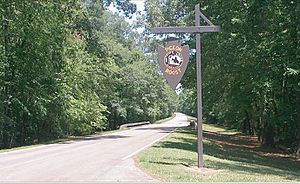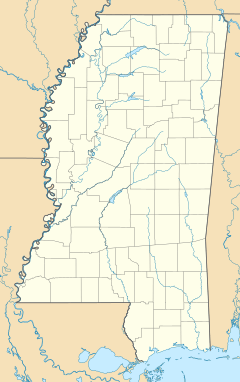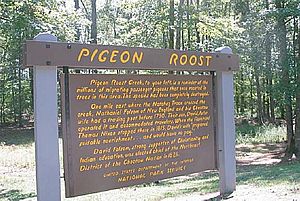Pigeon Roost, Mississippi facts for kids
Quick facts for kids
Pigeon Roost
|
|
|---|---|

Marker on Natchez Trace Parkway
|
|
| Country | United States |
| State | Mississippi |
| County | Choctaw |
| Elevation | 420 ft (128 m) |
| Time zone | UTC-6 (Central (CST)) |
| • Summer (DST) | UTC-5 (CDT) |
| GNIS feature ID | 685865 |
Pigeon Roost is a ghost town in Choctaw County, Mississippi. This means it was once a busy place where people lived, but now nothing is left of it. Long ago, it was home to a leader of the Choctaw people and an important stop on the Old Natchez Road.
Contents
History of Pigeon Roost
Pigeon Roost was located along the Old Natchez Road. This road crossed the Big Black River at this spot. The town got its name because millions of passenger pigeons used to gather and rest there.
Early Settlement and Trading
In 1790, Nathaniel Folsom from New England moved to the area. He opened "Folsom's Stand and Trading Post" in the Choctaw territory. This trading post became a part of the Natchez-Nashville Mail Route in 1821. Mail carriers would pass through Pigeon Roost on their way from Nashville to Natchez.
Nathaniel Folsom married a Choctaw woman named Ai-ni-chi-ho-yo. Her name meant "one to be preferred above others." She came from a long line of Choctaw chiefs.
David Folsom's Influence
Nathaniel and Ai-ni-chi-ho-yo's son, David Folsom, helped run the trading post. David became a very important person. He helped the Americans during the Seminole Wars in Florida and became a colonel.
David Folsom also helped create the first wagon road in the area. This road connected the Tombigbee River to the Yazoo River. He worked with early missionaries to clear the path from Pigeon Roost to their mission at Elliott.
Choctaw Leadership and Education
David Folsom became a powerful leader among the Choctaw people. In 1822, he met with Chief Mushulatubbee at Pigeon Roost. A famous Christian missionary, Cyrus Byington, lived with David Folsom in 1823. David was a strong Christian and taught Byington the Choctaw language.
In 1826, David Folsom was named Chief of the Choctaw Nation for its northern district. By the late 1820s, a school for Choctaw children was at Pigeon Roost. The community became a center for many Choctaw activities. There was also a cemetery there called Pigeon Roost Cemetery.
A post office operated in Pigeon Roost from 1842 to 1871.
The End of Pigeon Roost
In 1830, Pigeon Roost stopped existing as a settlement. This happened after the Treaty of Dancing Rabbit Creek. This treaty forced the Choctaw people to move away from Mississippi.
Today, a special marker recognizes the former community. You can find it at mile 203.5 on the Natchez Trace Parkway, near Pigeon Roost Creek.




